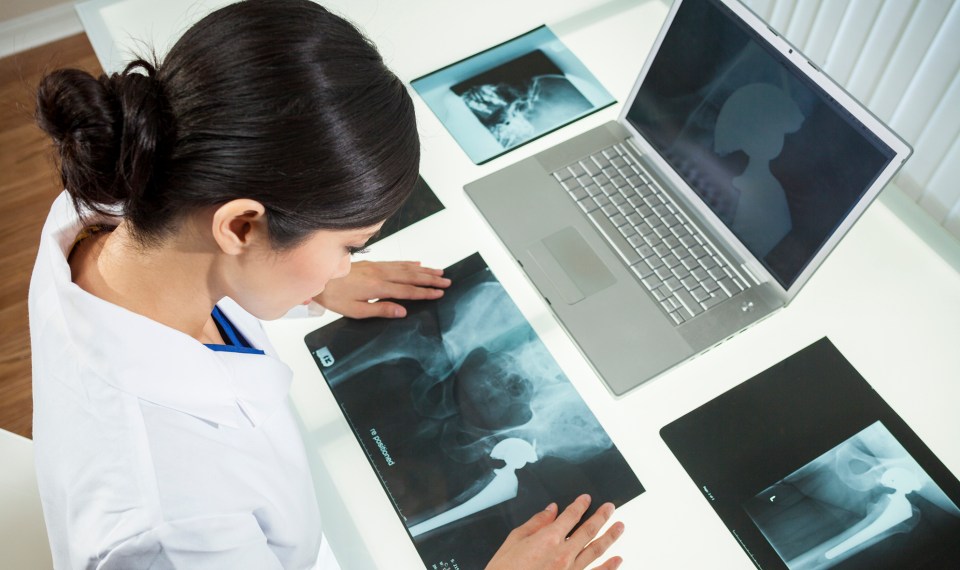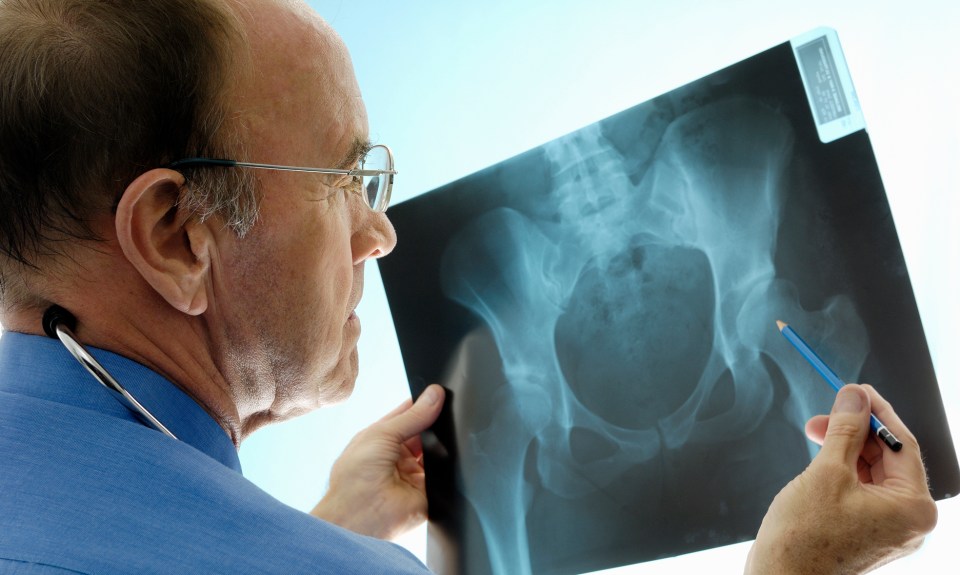Hip replacement surgery involves removing damaged components of the hip joint and replacing them with artificial parts. There are different types of hip replacement surgeries, but the replacement parts—prosthetics—are made of metal, ceramic or plastic, which are designed to move and function as a normal joint. According to the American Academy of Orthopaedic Surgeons (AAOS), hip joint replacement surgery is a common orthopedic procedure with more than 450,000 performed each year. Many patients who undergo hip replacement are in good health overall but have pain that disrupts and limits daily activity.
Hip Anatomy
The hip joint is located between your upper leg and torso. It is a ball-and-socket joint where the rounded top of the femur (long upper leg bone) fits into a socket of the pelvis called the acetabulum. Cartilage provides cushioning at the ends of the bones and allows them to move smoothly. The surfaces of the hip joint are covered with the synovial membrane which nourishes and lubricates the joint.
Reasons for Hip Replacement Surgery
Most hip replacement surgeries are performed because of joint pain and disability or a broken hip. Often pain occurs due to damage to the cartilage lining the ends of the bones. This damage can be due to arthritis, a bone fracture (break), tumor or avascular necrosis (damage caused by temporary or permanent loss of blood flow to the bones near the joint).
Hip surgery is not the first line of treatment. Your doctor will likely first try medications to reduce pain and inflammation, joint injections, modified activity or physical therapy. Walking aids, such as a walker, cane, or other device, may also be prescribed.
When the pain worsens to the point it disrupts sleep or interferes with activities of daily living like climbing stairs or doing self-care, your doctor may suggest surgery.
Preparing for Hip Replacement
When possible, preparation should start weeks before a hip replacement. You will need to schedule a medical evaluation as well as medical tests prior to surgery. Prepare for pre-op blood work, a urine test, electrocardiogram, stress test and chest X-ray. Your surgeon may also schedule other tests as needed. Some patients opt to donate their own blood prior to the surgery date so it is on hand should a blood transfusion be necessary. Other steps you can take to prepare include:
- Gather information from your surgeon and be sure you have a good understanding of the procedure and recovery.
- Talk to your surgeon about exercises that could strengthen your core, upper body and leg muscles prior to surgery.
- If you smoke, quit or decrease your smoking.
- Make transportation plans and arrange for household help while recovering.
- Set up your house to be accessible when you return home. Rearrange furniture and place items within reach.
- Consider renting or purchasing medical equipment such as a shower chair or grab bars.
Types of Hip Replacement
There are several factors that go into determining the types of hip replacement surgery that is performed.
- Partial hip replacement. As the name implies, in a partial hip replacement only certain components of the hip are replaced. Often the procedure is done to replace only the ball of the joint. The ball is removed and replaced with an artificial implant. Although not as common as a total hip replacement, you may be a candidate for this procedure if you have suffered a fracture of the femur neck, usually from a fall. It is not typically recommended if you have arthritis.
- Total hip replacement. In this procedure, both the ball and socket of the hip joint are replaced. The damaged cartilage and bone of the joint are removed and replaced with prosthetics.
Surgical Approaches for Hip Replacement
There are a variety of techniques used in hip replacement surgery. Your surgeon will determine how best to access your hip joint. Prior to surgery, the various approaches will be reviewed to determine which is best for your situation. Each carries its own benefits and risks.
- Posterior hip replacement. The most common approach, you will be placed on your side and an incision is made on the outside of the hip. This enables the surgeon to view the hip joint from behind the thigh bone.
- Anterior hip replacement. In this procedure, you’ll be positioned on your back and an incision will be made into the front of the thigh.
- Lateral approach. This approach requires you be positioned on your side and the incision is placed down the outside of the hip. The lateral approach is considered a balance between the anterior and posterior approaches.
Minimally Invasive
Sometimes, a minimally invasive hip replacement surgery is possible. This may reduce the damage to muscles, result in less pain, allow for a quicker and easier recovery, shorten your hospital stay, reduce the chance of hip dislocation and lessen the chance of a limp.
In a minimally invasive approach to hip replacement, your surgeon will make one or two small incisions to access the hip joint. You may be a candidate for a minimally invasive procedure if you have healthy bone without severe deformity of the femur, you are not morbidly obese, and you are committed to participating in physical therapy.
Recovering from Hip Replacement Surgery
Recovery from hip replacement surgery varies from person to person, but it will likely be three to six weeks before you can return to light activity. In the first day or two after surgery, you begin getting out of bed and walking. Regaining strength and mobility takes time, but you can typically expect a full recovery between six to 12 months.
For the most successful recovery, you should follow your surgeon’s instructions closely. You will likely be prescribed pain medications for a short time and will receive instructions on wound care. Keep the wound dry and bandaged until the sutures or staples are removed approximately two weeks after surgery.
Exercise is extremely important during the first weeks following surgery. You can expect to gradually increase walking, first indoors, then later outside. You will also be instructed on sitting, standing and climbing stairs. Exercises to strengthen your hip and improve movement should be done several times a day.
Some patients can return home after hip replacement, but inpatient rehabilitation may be the best option for you if you don’t have at home support or require more assistance. If you opt for an inpatient rehabilitation program, you should begin the program immediately upon discharge from the hospital. Benefits of inpatient rehabilitation after hip replacement include:
- A personalized recovery plan designed to help you build strength, mobility, and range of motion after an evaluation of your current health and physical ability.
- Easy access to medical care with frequent physician visits and 24/7 nursing care.
- A multi-disciplinary team of physical therapists, occupational therapists and other specialists to assist with your recovery.
- A transition time that can shorten the recovery process.
- Assistance with activities of daily living.
The content of this site is for informational purposes only and should not be taken as professional medical advice. Always seek the advice of your physician or other qualified healthcare provider with any questions you may have regarding any medical conditions or treatments.



